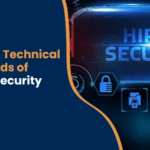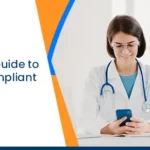What are the Technical Safeguards of HIPAA’s Security Rule?

July 17, 2025
Introduction
As healthcare shifts from paper-based systems to electronic health records (EHRs), patient information handling has become more streamlined. However, with medical records and personal health data now being managed electronically, the risks of data breaches and unauthorized access have increased.
A recent study found that, on average, 500 individuals were affected by a breach in healthcare records on July 19, 2024. To address these challenges, the HIPAA Security Rule mandates the implementation of technical safeguards.
Read on to learn more about the HIPAA technical safeguards in detail and how they benefit the healthcare industry.
What Is the HIPAA Security Rule?
The HIPAA Security Rule safeguards ePHI and sensitive medical data. It says that healthcare providers and covered entities must apply strong security rules to prevent unauthorized access, breaches, and misuse of patient data.
Overall, the HIPAA Security Rule protects data management by concentrating on the electronic storage and transmission of data. It provides systematic rules that businesses must adhere to so that ePHI is protected from external threats and kept confidential.
Furthermore, the rule establishes federal restrictions to protect patients’ health information privacy. To comply with these regulations, three key types of security procedures are used, which are discussed as follows:
- Administrative Safeguards: These policies are designed to manage the selection, development, and use of safety measures to protect ePHI. They also include employee training and oversight. A HIPAA training course ensures your staff stays compliant with HIPAA regulations.
- Physical Safeguards: This includes measures that control physical access to facilities and systems. This ensures that only authorized personnel can access sensitive information.
- Technical Safeguards: This category involves using technology to protect and control access to ePHI. Technical safeguards defend against cyber threats and ensure data integrity.
Read more: Why Is HIPAA Important?
HIPAA Technical Safeguard
HIPAA technical safeguards are an integral part of any healthcare organization’s cybersecurity strategy. They help organizations comply with HIPAA regulations and protect patient information from potential breaches. Organizations must implement security measures based on their unique needs and risks. For instance, a smaller healthcare system may not need the same level of endpoint security as a large health information exchange.
The Health and Human Services (HHS), in its HIPAA Security Series, states that entities should evaluate several factors when determining the appropriate safety measures, which are:
- Identifying potential risks to ePHI and determining steps to mitigate those threats.
- Understanding the available resources for implementing security measures.
- Considering the complexity of the organization and the costs associated with the implementation of protective measures.
- Finally, it helps to adapt security measures based on the entity’s scale and operational scope.
While HIPAA does not mandate the use of specific technologies, it does expect organizations to implement relevant measures to meet security standards.
Read more: What is HIPAA Compliance?
Five Technical Safeguards of HIPAA Security Rule
Technical safeguards serve as the backbone of the HIPAA Security Rule, specifically designed to prevent unauthorized access and protect against data breaches. These cover a range of practices and technologies to ensure the confidentiality, integrity, and availability of ePHI.
-
Access Control
Access control means only authorized personnel, like doctors and nurses, can access sensitive patient information stored in electronic health records (EHR). Implementing access control ensures that authorized people can see the limited information they need to do their job without giving access to the whole information.
Healthcare organizations can follow several practices to comply with HIPAA. One approach is using access controls to make sure only authorized individuals can view sensitive information. This includes assigning unique usernames and strong passwords to confirm a user’s identity before access is granted.
Another method is log-off automation, where systems automatically log users out after a period of inactivity, reducing the chance of unauthorized access. Many organizations also use advanced technologies like fingerprint or facial recognition systems to verify identities and provide extra security.
-
Audit Control
Audit controls help healthcare organizations track who accesses ePHI and how it is recorded. They show which staff members have looked at or changed patient records. This monitoring is important to ensure that ePHI is kept secure and used appropriately.
Healthcare organizations can adopt several strategies to improve audit controls and protect ePHI. One method is using automated audit tools to monitor access. These tools create logs that track who accessed information and when, making it easier to manage data security.
Regular risk assessments are another approach, helping organizations find potential issues in their audit systems and decide on improvements or added protections. Keeping detailed documentation of audit controls is also useful, providing evidence during reviews or audits to show compliance with HIPAA regulations. These practices work together to strengthen data security and meet regulatory standards.
-
Data Integrity Controls
Data integrity means that information has not undergone “improper alteration or destruction.” Proper management and maintenance of data integrity is required for patient safety, as missing or altered information can lead to incorrect diagnoses and inappropriate treatments.
Unexpected issues like system glitches or human mistakes can sometimes affect data integrity. To protect ePHI, organizations can implement various controls. One is maintaining off-site data storage for at least six years to safeguard against physical damage and preserve the original format.
Access controls, such as “allow only” or “least privilege” settings, limit staff access to ePHI to only what is necessary, reducing the chance of accidental changes. Automated confirmation prompts, like “Are you sure you want to proceed?” or “Are you sharing data with third parties?” help prevent unintentional data loss by prompting users to confirm their actions.
Another useful method is checksum verification, which involves using algorithms to compare transmitted data with the original to detect any unauthorized changes. These strategies ensure that data remains accurate and secure.
-
Person or Entity Authentication
Person or entity authentication is mandated by HIPAA to protect ePHI. This procedure requires an identification test of individuals or entities trying to access sensitive patient information.
Healthcare organizations must implement robust person or entity authentication controls, supported by regular staff training on secure login practices. Popular methods for authentication, particularly for accessing ePHI, include several key strategies.
First, the use of login credentials serves as the initial defense by requiring users to enter unique usernames and strong passwords, promoting accountability and reducing the risk of cyberattacks. Second, two-factor authentication (2FA) enhances security by requiring users to provide two forms of identification, such as a text message or email verification, to gain access. Lastly, biometric authentication offers an advanced approach, utilizing unique biological traits, such as fingerprints or facial recognition, to verify user identity.
-
Transmission Security
Transmission security is to protect ePHI as it is transmitted between healthcare entities. The goal of transmission security is to prevent unauthorized interception or access to sensitive patient data during electronically exchanged communication.
Implementing transmission security measures protects patient information and supports HIPAA compliance. Encryption converts information into a coded format that only authorized individuals can access, using protocols like Secure Socket Layer (SSL) and Transport Layer Security (TLS) for secure internet transmission.
Secure connections, such as Virtual Private Networks (VPNs), create encrypted tunnels for data transmission, reducing the risk of unauthorized access. Assessing data integrity through methods like hash functions and checksums validates that transmitted information remains unchanged.
Why HIPAA Matters in Healthcare Security
The HIPAA security rules are designed to protect ePHI and ensure its confidentiality, integrity, and availability. The basic five technical safeguards are Access Controls, Audit Controls, Data Integrity, Person or Entity Authentication, and Transmission Security. These measures can help Healthcare organizations mitigate the risk of data breaches and unauthorized access to sensitive patient information.
Failure to adhere to these can lead to serious consequences, including legal penalties. Additionally, it is not just about avoiding penalties but also about building trust with patients and the future of healthcare organizations.





